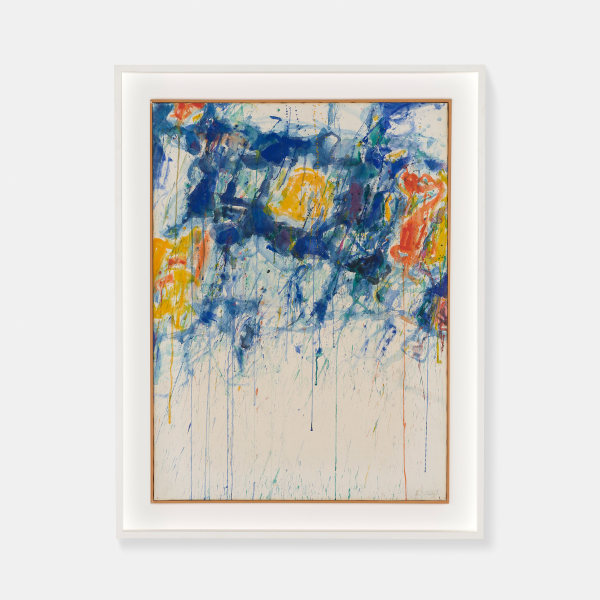Paris: An Experimental Reality
-
Overview
Timothy Taylor is pleased to present Paris: An Experimental Reality at the gallery’s London space. This group exhibition is dedicated to the dynamic conversations among a group of expatriate painters in Paris in the years immediately following the Second World War, spurring an extraordinary body of work by artists including James Bishop, Sam Francis, Carmen Herrera, Shirley Jaffe, Paul Jenkins, Ellsworth Kelly, and Joan Mitchell.
The seven artists featured, who worked in a spectrum of painterly modalities informed both by American Abstract Expressionism and European Modern art, were all drawn to the city in the years between 1948 and 1957. It was a time of renewed artistic energy in the City of Light, one which, while initially overshadowed by the concurrent rise of Abstract Expressionism in New York, had a major impact on the history of Modern art. Of the male artists included in this show, all but James Bishop (who narrowly avoided conscription) had previously encountered Europe as soldiers during World War II. They returned to the city after the war in hopes of furthering their practices and found inspiration within Paris’s vibrant cultural scene.
In addition to offering a respite from the heavy shadow of the New York Ab-Ex style, postwar Paris also provided an artistic refuge for female artists. The Cuban-born painter Carmen Herrera, who had struggled to find outlets for her work in New York, emigrated to Paris in 1948 and quickly embedded herself in the Parisian intellectual milieu. The city would have a lasting influence on her practice, spurring her move from figuration to abstraction. During her tenure in Paris she made groundbreaking innovations in her work, including a series of black-and-white geometric paintings extending across multiple canvases that would serve as a precursor for Hard Edge abstraction. Herrera’s 1949 Les Liens, on view in this exhibition, exemplifies this transitional period in her oeuvre and indicates the city’s dramatic effects on her practice.
Several of these artists were also friends who supported each other’s careers. Shirley Jaffe arrived in the city in 1949 with her G.I. husband who was studying at the Sorbonne. Here she encountered the painters Ellsworth Kelly and Joan Mitchell. She joined the inner circle of Sam Francis; the painter later introduced her to his Parisian dealer, who ultimately showed her work. While Francis himself would travel widely throughout his career, his own work was indelibly changed by his encounter with French Tachisme (“stain”) painting, and the artist became known for his work in this style during his years in Paris.
This friendship among equals (a rarity between male and female painters during the time) was exemplified by that between Mitchell and Paul Jenkins, who periodically exchanged studios during the 1950s–with Jenkins working at Mitchell’s St. Marks Place studio in New York while she painted in his Rive Gauche atelier. This exchange allowed the artists to retain professional ties to their respective Manhattan galleries while enjoying the artistic freedom afforded by Paris.
Paris: An Experimental Reality evidences the wide range of approaches to abstraction taken by this fortuitously synced group of peers, who each carved new avenues of expression inspired by the city that embraced them.
-
Artworks
-
 Carmen HerreraLes Liens1949Acrylic and sand on canvas29 x 36 in. (73.7 x 91.4 cm)
Carmen HerreraLes Liens1949Acrylic and sand on canvas29 x 36 in. (73.7 x 91.4 cm) -
 Paul JenkinsPhenomena Noh Veil1969Acrylic on canvas39 ⅛ x 39 ⅛ in. (99.1 x 99.1 cm)
Paul JenkinsPhenomena Noh Veil1969Acrylic on canvas39 ⅛ x 39 ⅛ in. (99.1 x 99.1 cm) -
 Sam FrancisUntitled (Blue, Yellow, White)Circa 1956Watercolor and gouache on paper laid down on canvas29 ⅞ x 22 ⅛ in. (76 x 56.2 cm)
Sam FrancisUntitled (Blue, Yellow, White)Circa 1956Watercolor and gouache on paper laid down on canvas29 ⅞ x 22 ⅛ in. (76 x 56.2 cm) -
 Joan MitchellUntitled1956Oil on canvas24 x 21 in. (61 x 53.3 cm)
Joan MitchellUntitled1956Oil on canvas24 x 21 in. (61 x 53.3 cm)
Framed: 30 ¼ x 27 ⅛ x 1 ⅞ in. (76.8 x 68.9 x 4.8 cm) -
 Shirley JaffeSans titre1965Oil on canvas69 ½ x 77 ½ in. (176.5 x 197 cm)
Shirley JaffeSans titre1965Oil on canvas69 ½ x 77 ½ in. (176.5 x 197 cm)
-
-
Installation Shots















